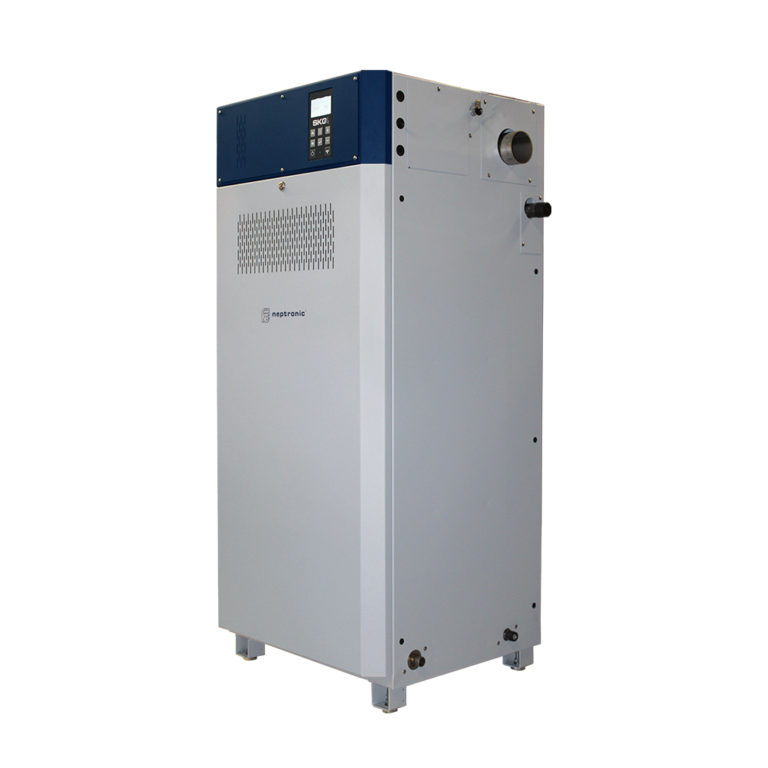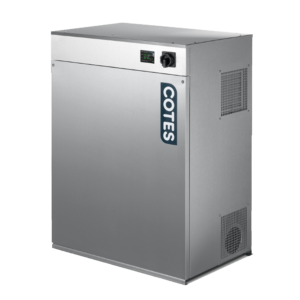Printing presses are fickle things. So is finishing equipment, cutting equipment, and all the other equipment that a printing company uses on a daily basis to provide their services. This equipment can be very sensitive to changes in temperature, humidity and atmospheric pressure. The problem is, printing companies have invested a lot of money in their equipment and paper stock, and the last thing they want is for it to be ruined by humidity. A good print company will be willing to invest slightly more to ensure the long life and efficiency of that print equipment, whether it’s digital or litho.
Without some sort of humidity control, machines and paper stock are exposed to uncontrolled environments where the climate could change on an hourly basis. Low humidity can draw moisture from paper causing curling and tight edges. High humidity will affect the performance of both paper and machines. But a stable humidity reduces static and improves the dimensional stability of the paper – creating a seamless and consistent print environment. It’s so important that press manufacturers actually require effective humidity control to maintain effective performance of their equipment, and detail the exact levels you should be maintaining in the operating manuals.
So, how can printing companies control their print environment to get the best out of their machinery, equipment and people?
Air Quality
Just as importantly, humidity is a big contributor to indoor air quality. Poor air quality can lead to illness in staff, a lack of productivity and a much higher rate of absenteeism and employee turnover. To give you an example – low humidity (which is the most common problem in the UK) can make your eyes itchy (particularly for contact lens wearers), dry out your respiratory surfaces and dehydrate your body. Drying out the mucous membranes in your body also means you can’t fight off airborne infections like colds and the flu as effectively, so you’re more likely to catch bugs. On top of that, if your environment has a relative humidity of under 40% then you will feel a lot colder than it actually is. Your natural response will be to turn up the heating, increasing energy consumption and lowering the humidity even further, creating a cyclical problem.
Tailored Approach
Here’s the thing – no two print environments are the same. So no two solutions should be the same either. It’s important to make sure that the humidity solution you put in place is tailored to the conditions of the building and the types of machinery being used – which requires a specialist. At Humidity Solutions, we don’t believe in a ‘one size fits all’ approach. Instead, each project is evaluated against a number of key criteria, so that the best solution is identified from all options available on the market.
Ideal Options
So what’s the ideal solution? Well, for litho, large digital and web-based printers, a high-pressure system is perfect. High-pressure systems inject water into the air under pressure through a multi-directional, fan assisted set of nozzles. The pressure helps ensure the water is atomised and absorbed rapidly and evenly into the air within 1.5 metres of the nozzle. The systems can be used with ceiling heights as low as 2.4 meters, with nozzle fan heads around the same size as a CCTV camera, so they are unobtrusive and can slot into any print environment. They can also be controlled by zones or individually, helping control the rate of humidification for each unique space from one control panel.
A key benefit of this approach is that it uses cold water, so no additional heat energy is required to run it. The absorption into the air (adiabatic humidification) also has a free cooling effect, which reduces the load on comfort cooling systems and helps them run more efficiently. For every 500 litres of water that’s evaporated the system provides around 34 kW of cooling for a power input of just 4kW. High-pressure systems have been successfully installed in many renowned web press publishing houses including the New York Times, News International, and the Daily Mail.
For smaller, digital print rooms Humidity Solutions have designed a bespoke unit – the Eiger. It provides temperature and humidity control plus air filtration, air movement and fresh air from a single unit to ensure conditions remain in the Quality zone for optimum machine speeds and print quality.
So Why Is Humidity Control Important?
It’s not just important, it’s an essential part of the printing process, and all press manufacturers require humidity control to ensure the effective performance of their equipment. Print halls are rarely seen without humidity controls in the rest of Europe, and now the UK is catching up with the benefits of humidity control and its implementation. It’s also worth noting that it’s not an overly expensive solution to implement – despite what you might think. And besides, compared to the cost of under-performing machines, constantly re-buying equipment and high staff turnover, it’s the cheapest solution you will ever implement.
At Humidity Solutions, we provide effective humidity control solutions for all shapes and sizes of print company, from small independent units to large-scale print houses. Your solutions will be tailored to your needs, so you can be sure your RH and infection are being managed and controlled effectively. For more information on our solutions, or to ask us about print control in your organisation, just get in touch with the teamat Humidity Solutions today.
John Barker has published a guide to designing climate control systems for print: ‘Humidity and Temperature Control for Print’. To receive a free electronic copy of this book, please visit our website www.humiditysolutions.co.ukor use the following direct link: http://www.humiditysolutions.co.uk/humidity-solutions-print-book-form/

